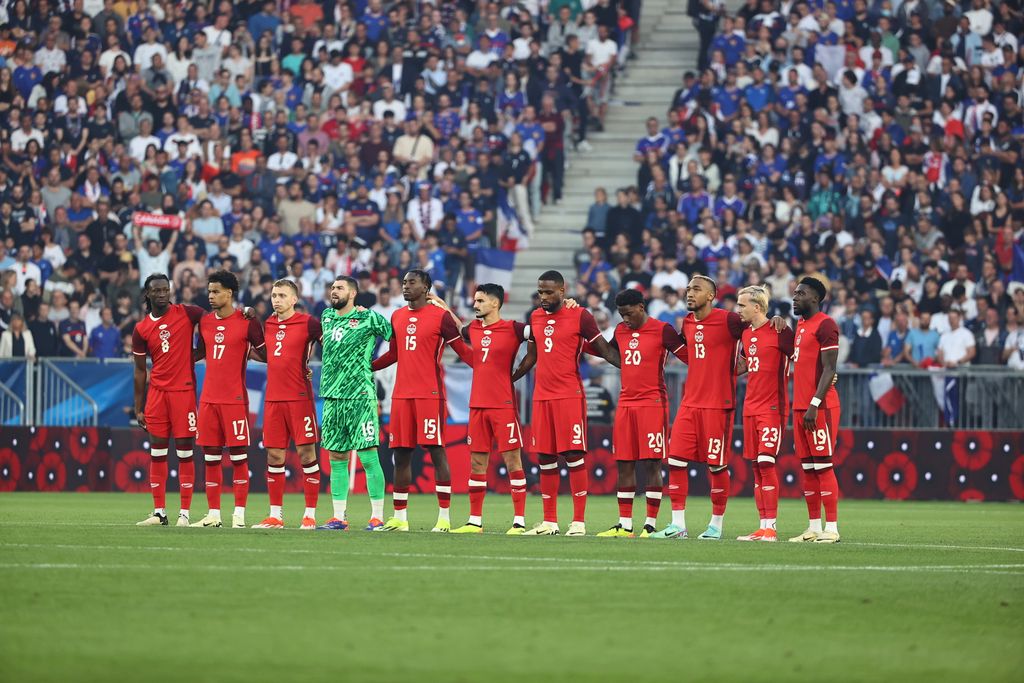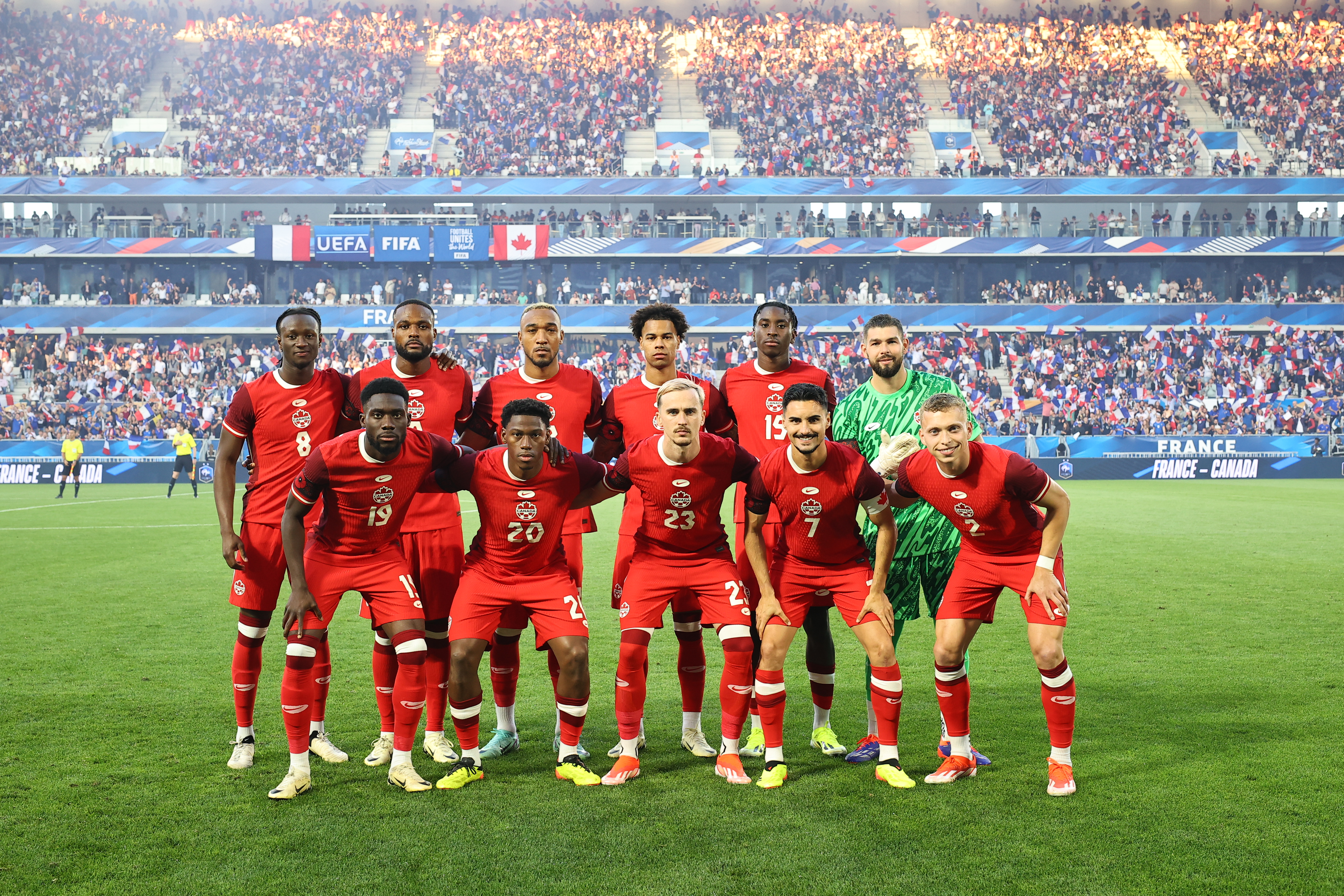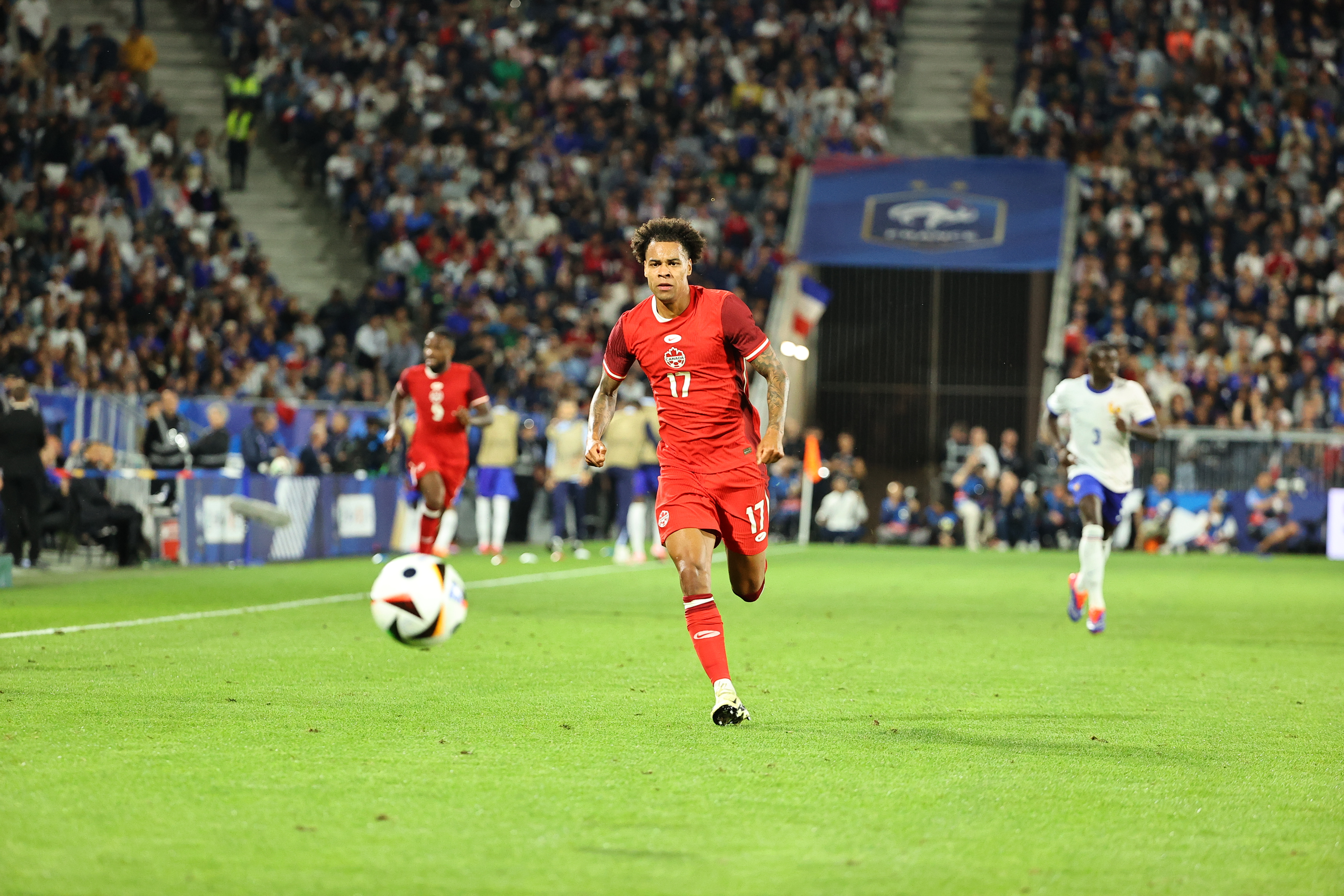3 KEY takeaways from the CanMNT's 26-player Copa América squad

The Canadian Men’s National Team are officially Copa América bound, as they named their 26-player squad for that tournament on Saturday.
Coming off the back of new head coach Jesse Marsch’s first camp with his team, in which they fell 4-0 to the Netherlands and then drew France 0-0 in two friendly matches, he made a few tweaks to the roster from that camp, which included 27 players, of which he already had to get down to 26 for Copa América.
As a result, he took out three names - Iké Ugbo, Charles-Andreas Brym and Dominick Zator, who he replaced with two new faces - Ali Ahmed and Jacen Russell-Rowe, to finalize his squad.
Our #CANMNT Copa América squad is HERE!
— CANMNT (@CANMNT_Official) June 15, 2024
The 26 who will lead us into battle⚔️
Presented by @CIBC
——
Notre sélection pour la Copa América est ICI !
Les 26 joueurs qui nous mèneront au combat ⚔️
Présenté par @CIBC
Unfortunately for him, he had little time to work with his final group, as they already had to make a change by Sunday morning, with Joel Waterman coming in for an injured Junior Hoilett, but he’ll now hope that’s the last of the changes he has to make before their tournament opener on Thursday, June 20th against Argentina.
Joel Waterman called into Copa América squad to replace the injured Junior Hoilett.
— CANMNT (@CANMNT_Official) June 16, 2024
——
Joel Waterman appelé en sélection pour la Copa América en remplacement de Junior Hoilett.#CANMNT
Now just days away, a crucial week of training awaits, as Canada gets set to tackle this tournament for the first time, starting with that Argentina match before they take on Peru and then Chile to round off their group.
With that in mind, here’s a look at what stood out from that squad reveal, which went mostly as expected, even if it included a few surprises.
Ugbo’s omission the biggest surprise among squad changes:
To begin, it’s worth taking a deeper look at those changes, as there’s lots to dive into from those omissions and additions.
First, there were the four names who were taken out of the squad, which are Ugbo, Brym, Zator and Hoilett.
To begin, there’s Ugbo, who is the biggest surprise omission. Given that he’s coming off a half-season on loan for Sheffield Wednesday where he scored seven goals and added one assist as he helped them secure a miraculous survival in the Championship, he was expected to be a key piece under Marsch going forward.
Both due to his form, as well the style of play employed at Wednesday, which includes a lot of pressing, it was expected that Ugbo could finally get his chance to earn a regular spot in this Canadian side, having played 216 minutes across nine appearances since committing to the program in 2021, which included just two starts.
Unfortunately, he wasn’t able to add to that tally in the European friendlies, as he, Theo Bair and Luc De Fougerolles were the only three outfield players not to play in that camp, and he’ll now miss out on a chance to play in this tournament, which is a huge surprise given his form.
Naturally, Marsch was asked about it, as many wondered if there was more to Ugbo’s exclusion, and it turns out there was - according to Marsch, Ugbo asked to be excused from the tournament, citing a need for a break, which is a more than understandable explanation. Given that Ugbo’s club future is uncertain, too, as he headed back to parent club Troyes from Wednesday, with Troyes now in the French third tier after consecutive relegations, this extra time will help him in his hunt for a new club, too, even if one could wonder what he could’ve done to help that quest had he been given a shot at Copa América.
"Yeah, Iké was invited to camp, and he decided for personal reasons to take a break," Marsch said of Ugbo. "He just felt it was right for him. We had a long conversation, I respected his decision, and I understand where he's at, but it won't be the last that we see from Iké, I think he's ready to take a little bit of a break, get back into his club, and then keep pushing his career again, so we talked about the possibility of what September might look like."
Otherwise, Brym and Zator’s absences were less than surprising. Both players were at positions where Canada has the most depth, with Brym one of many forward options Canada has, while Zator was set to battle with Alistair Johnston and Richie Laryea at right back, meaning it was expected they’d miss out, especially after they were left out of Canada’s pre-tournament squad this past week.
Lastly, Hoilett’s late exclusion was a big surprise, given that it came from a last-minute injury, and his absence will be felt. He was unlikely to play more than a supersub role at the Copa América, but those minutes he would’ve played were expected to be valuable, as he could’ve injected quality into games off the bench.
Able to play anywhere in the attack, and arguably one of Canada’s most dangerous creators (and set-piece specialists), those skills could’ve been quite valuable in the right set-up.
On the other side, there were of course those who were brought in, consisting of Ali Ahmed, Jacen Russell-Rowe and Joel Waterman.
To start, Ahmed was an expected inclusion, after his omission from the European camp stood out. Able to play in multiple positions, the Whitecaps midfielder was expected to fit perfectly into Marsch’s system, making this inclusion an exciting one.
At his best when he can drive the ball forward, he can bring some attacking creativity for a team that could use some more, although it’ll be curious to see A) where Marsch sees his best position as given that he can play anywhere across the front six in Marsch’s 4-2-2-2 as well as at full back, and B) how big of a role he can play in this Copa América.
Then, there’s Russell-Rowe, who stands out given that he’s the second-youngest player on this squad after Luc De Fougerolles. In the middle of a strong season for the Columbus Crew, where he has five goals and one assist in all competitions, including several big goals in a run to the Concacaf Champions Cup final, he felt like he had an edge to earn a spot in Canada’s busy frontline.
Able to play as a natural #9 but also as a withdrawn forward, his profile brings something different to Canada’s attack, making his inclusion an exciting one.
Lastly, Waterman brings some much-needed centre back depth to a team that was a bit short of it in their original Copa América squad, which is likely why Marsch turned to Waterman as soon as he had a spot open up for him. An excellent passer of the ball, one can wonder if Waterman gets thrown into any game where Canada might have more possession, and as he showed for Montréal in his last game before his departure, in which he played some midfield, he can also fill in higher up the pitch having started his career at that position.
What to make of the depth:
 Now that Canada’s Copa América squad is finalized, it’s interesting to dive into the make-up of this squad, which is certainly intriguing to see.
Now that Canada’s Copa América squad is finalized, it’s interesting to dive into the make-up of this squad, which is certainly intriguing to see.
In particular, the big things to watch were how Marsch would navigate positions of strength, as well as some positions where Canada might not be as strong.
When looking at the roster, a few areas stand out on both sides of that ledger.
To begin, things are expected to be relatively straightforward in goal - Maxime Crépeau likely enters this tournament as the starter after a strong showing versus France, while Dayne St.Clair isn’t far behind him after a decent showing against the Netherlands despite the scoreline.
Over at centre back, things were a bit light before Waterman’s inclusion given they had just four names including the unproven Luc De Fougerolles, but with there now five players who can play at the position, and Marsch expected to continue with a back four, that position should be in good hands.
At full back, things are in good hands on the right side with Alistair Johnston and Richie Laryea battling for minutes there, and Tajon Buchanan an option if needed, but the same can’t be said on the left, where Alphonso Davies is the only natural option, with Laryea, Kamal Miller, Kyle Hiebert and Liam Millar all able to slot in there if needed.
In midfield, Canada’s now got six midfielders with the inclusion of Ahmed, although they’re light on natural defensive midfielders, with Stephen Eustáquio and Samuel Piette those best suited for that role, and even Eustáquio is seen as more of an #8. Interestingly, Canada is also light on attacking midfielders, too, especially with Hoilett’s absence, although Jonathan Osorio, Ismaël Koné and Ahmed can all play there.
Meanwhile, out wide, Canada is set in terms of left wingers but a bit light in terms of right-wingers, although most of their left-sided options have experience on the right, so that shouldn’t be a problem.
Then, up front is arguably Canada’s deepest position, as despite leaving Ugbo and Brym at home, Canada still has five natural strikers in this squad, giving them plenty of options to play with there.
With the addition of Joel Waterman to the #CanMNT squad here's an update to that depth chart of their Copa América squad, as some of those CB concerns are alleviated, and the FW depth gets a little lighter with no Junior Hoilett https://t.co/gXo3KZbTCz pic.twitter.com/7Mtfjf4JAi
— Alexandre Gangué-Ruzic (@AlexGangueRuzic) June 16, 2024
Therefore, overall, Canada’s done well to balance out their squad, especially after Waterman’s inclusion. Yet, that’s the benefit of the squad’s being capped at 26 players instead of 23, which can allow teams to have more cover across the field, and still having room to bring a younger player like De Fougerolles to experience the environment in the hope of helping his future development.
Because of that, Marsch is pleased where his team is at heading into this tournament, and is also excited to see what they can still do as he continues to work with them in the weeks to come.
"I've really enjoyed the last two weeks, working with the team has been very rewarding," Marsch said of his group. "We've seen a lot of progress in a short amount of time, which makes me optimistic for the future, but I've tried with the group to keep our foot on the pedal and make sure that they all know that we've still got a long way to go to become the team that we need to become."
Who has the most to prove?
Now, of course, the intriguing thing will be to see how the battles shape up within the squad now that the group is finalized.
For the most part, one would expect the starting lineup for Canada’s opening game against Argentina to be relatively straightforward - in fact, barring any major surprises, it’ll likely be the exact same group Marsch ran out against France who starts that opening game.
Yet, as seen across that camp, there are some battles to watch across the pitch, and some players who will have lots to prove this camp.
Jesse Marsch also says that he'll name a #CanMNT captain over the next few days
— Alexandre Gangué-Ruzic (@AlexGangueRuzic) June 15, 2024
To start, Alphonso Davies is the big one. Naturally, given how important he is to this Canadian team, a lot of eyes will be on him, especially given that Marsch has pushed him to become more of a leader and to simplify his game. Of course, it’ll be intriguing to see where he plays - he looked likely to play higher up the pitch before getting put at left back in the Netherlands and France games - but no matter if he sticks at left back or plays on the wing, he’ll be key to Canada’s success in this tournament.
Speaking of key players, the same can be said of Jonathan David, who has a lot to prove in this tournament. A prolific scorer for Canada, he’s struggled to find the same sort of success he’s had in Concacaf against non-Concacaf opposition, making this a big test for him to prove that’s been circumstantial, as he’s proven at the club level that he can score in big games against big teams. After not scoring at the 2022 World Cup, he’ll want to find the net on multiple occasions in this tournament, showing that he can step up for Canada in these sorts of games.
Otherwise, Tajon Buchanan will have a lot of eyes on him after his move to Inter Milan, as he looks to prove why he made that move. As seen at his strong 2022 World Cup, where he was arguably Canada’s best performer, he’s shown he can step up in big tournaments, and he’ll need to do so again here. 
Elsewhere, among those in the starting eleven from that France game, Cyle Larin feels closest to losing a starting spot, as his partnership with David has struggled to bear fruit in bigger games. It’s hard to imagine the CanMNT’s all-time leading scorer dropping out, but unless he can get back to scoring ways, his spot could be at risk for two reasons, as A) Canada might need to tweak up the partnership just to get more out of David, and B) They've got a lot of names beyond Larin who can be looked at to help them to do just that.
Shifting away from some of the more established names, Moïse Bombito could be set to be Canada’s breakout player this tournament (to be fair, that can also be said of Ismaël Koné, although his breakout has already happened for Canada, with this summer likely to be his breakout in front of a mainstream audience). Despite entering the Netherlands and France games with just four caps under his belt, Bombito started and went 90 in both games, putting in two strong performances against two teams loaded with attacking talent, showing why he’s viewed as someone who will be the cornerstone of this defence for years to come. For a team that has struggled at that position before, his profile, which includes his size, speed and passing ability, has made him a huge find, and he’ll look to show why in this tournament.
Lastly, despite his late inclusion, Ali Ahmed is a wild card to watch in this tournament. He’s shown it in the past for club and country - he just needs an opportunity, and he’ll make the most of it. No matter if it’s off the bench or as a starter, and no matter the position he’s asked to play, he makes things happen when he’s on the field. So even if he might start the tournament as a supersub, don’t be surprised if he can win a bigger role as the games go on, as that wouldn’t have been the first time he’s done that in his fledgling career.

